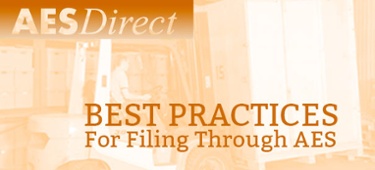
The U.S. Census Bureau offers free or low-cost instruction to everyone involved in international trade. They provide newsletters, suggestions and recommendations on Automated Export System (AES) best practices. They have worked diligently to develop regulations that we can read and readily understand.
Census has done all they can do to prepare companies for filing their Electronic Export Information (EEI) through the Automated Commercial Environment (ACE) platform, the government's portal for AESDirect. But it is the responsibility of exporters and their respective freight forwarders to develop a response to the changes that occur in the regulations. In this case it is the Federal Trade Regulations or FTR—15 CFR 30.
Shakespeare wrote, "To thine own self be true." This oft-quoted line is applicable to the change in the regulations. Where to start? Start by filling in a basic schematic of who handles the export documentation within your organization. Identify who files the EEI for your export transactions. If it is a freight forwarder, who provides the detail and how is it provided to the freight forwarder or agent who will complete the EEI filing?
Once a schematic has been drawn, then layer on the regulatory requirements. These include, but are not limited, to:
Selecting a Harmonized Tariff Schedule of the U.S. (HTSUS) or Schedule B number;
Verifying the country of origin, at minimum, identifying whether the goods are Domestic (D) or Foreign (F);
Identifying whether products being exported are subject to export control or not, such as an Export Control Classification Number (ECCN);
Screening transactions against the U.S. government's Consolidated List, plus additional sanctions as announced by other agencies such as the Office of Foreign Assets Controls;
Verifying the destination country to eliminate the possibility of shipping to a restricted or embargoed country without the proper license or authorization; and
Establishing who will submit the EEI through AESDirect for your firm's export transactions.
What often stops companies from going forward is the great unknown of mapping this process, or one of several excuses such as: "I don’t have time to go into all that detail," or "This is a job for someone else."
To jumpstart the process, here's a template with one caveat: IT IS INCOMPLETE! It needs your input and that of others in your firm—such as purchasing, engineering, legal, sales and export compliance—to finalize the who, what and when of filing an EEI.
Step-by-Step: AES Yes or No?
First, identify the classification of each item on a data sheet alternatively on an invoice (whether a proforma, customs or commercial).
Second, identify the country of origin for each line item; at minimum, whether the goods are domestic or foreign. FTR Part 30.6 requires the division of products into a subset of Domestic (D) or Foreign (F). Segregate the products by classification to 10-digits, then into subset by D or F.
Third, verify whether the product is subject to export controls stated within the Export Administration Regulations, International Traffic in Arms Regulations, or the Nuclear Regulatory Commission's regulations.
Here's an example:
Your customer orders 10 table fans under Schedule B code 8414.51.0090 that are country of origin U.S.A. or (D) and have a total value of $2,400 including transportation and insurance expenses. The fans were reviewed for export control purposes, and they were deemed as EAR99 or general products not subject to additional export controls.
The customer also orders 10 table fans that have the same Schedule B code 8414.51.0090 they are also EAR99, but the country of origin is China or (F) with a total value of $2,400 including transportation and insurance expenses.
Although the total value of the fans is $4,800 under 8414.51.0090, you would not need to file your EEI through AESDirect since neither the domestic (D) nor the foreign (F) goods under 8414.51.0090 exceeds $2,500. The Low Value Exemption will be reported on the international bill of lading and other commercial documents as required. The low-value exemption statement is NOEEI Sec. 30.37(a).
Caveat: The Low Value Shipment exemption cannot be applied if the allocated transportation and insurance costs to the port or airport are $100 and applied as follows:
Foreign—$2,400 plus $100 for transport and insurance = $2,500, EEI required
Domestic—$2,400 plus $100 for transport and insurance = $2,500, EEI required
(By the way, here is a quick list of articles on our site about AES.)
Mapping the Process: Electronic Export Information in AES
For the exemption and citation remarks required by AES on the commercial invoice and international bill of lading, check Appendix D of the FTR.
Remember, this flowchart is designed to help you create one tailor-made for your own company.
( Milissa )26 Jun,2017


